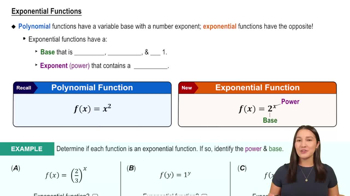State whether each function is increasing, decreasing, or neither.
c. Height above Earth’s sea level as a function of atmospheric pressure (assumed nonzero)
 Verified step by step guidance
Verified step by step guidance Verified video answer for a similar problem:
Verified video answer for a similar problem:



 6:21m
6:21mMaster Properties of Functions with a bite sized video explanation from Patrick
Start learning